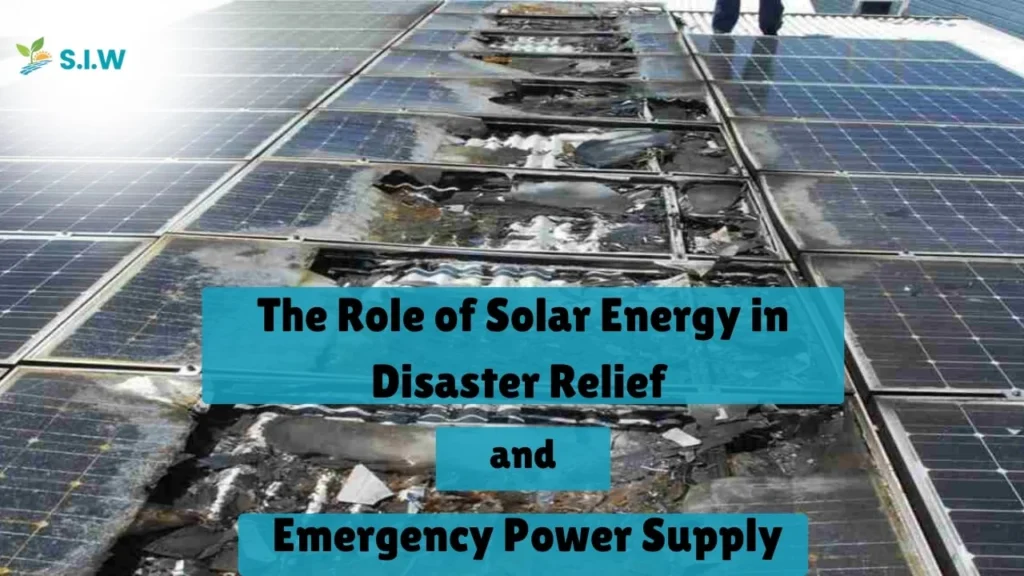In times of disaster, access to reliable power can be crucial. Solar energy provides a sustainable solution to this problem, particularly when traditional power sources fail. Solar panels harness sunlight to generate electricity, making them an ideal option for emergency situations where grid power may be unavailable.
In this blog, we will explore how solar energy plays a significant role in disaster relief and emergency power supply, the benefits it offers, and real-life experiences demonstrating its impact.
How Solar Energy Works
Solar energy is harnessed through photovoltaic (PV) cells, which convert sunlight directly into electricity. These cells are typically found in solar panels. When sunlight hits these panels, it excites electrons, creating an electric current. This electricity can then be stored in batteries for later use or fed directly into an electrical system.
Benefits of Solar Energy in Disaster Relief
- Immediate Availability: Unlike traditional power sources, solar panels can be set up quickly and do not rely on fuel delivery. This makes them particularly useful in disaster-stricken areas where infrastructure may be damaged.
- Portability: Many solar energy systems are portable and can be deployed in various locations. For instance, portable solar generators can be transported easily to provide power for medical facilities or shelters.
- Sustainability: Solar energy is renewable and sustainable, meaning it won’t run out as long as the sun shines. This makes it an excellent long-term solution for regions frequently affected by natural disasters.
- Cost-Effective: After the initial investment in solar technology, the ongoing costs are minimal. With no fuel costs and low maintenance, solar systems can save money over time.
- Reduced Carbon Footprint: Utilizing solar energy in disaster relief efforts minimizes reliance on fossil fuels, contributing to a reduction in greenhouse gas emissions.
Case Studies of Solar Energy in Disaster Relief
Hurricane Katrina
In the aftermath of Hurricane Katrina in 2005, many areas in Louisiana experienced extensive power outages. Solar energy played a vital role in providing immediate electricity. Organizations like the Solar Energy Industries Association (SEIA) sent solar panels to the region to power emergency shelters and essential services.
These installations provided light, communication systems, and refrigeration for food and medicine. The ability to generate power locally allowed communities to recover more swiftly than they might have otherwise.
California Wildfires
In California, solar energy has become an essential resource during wildfire seasons. The devastation caused by wildfires often leads to widespread power outages. In response, many residents have turned to solar power systems to maintain electricity during these critical times.
Portable solar generators have been utilized to power homes, medical equipment, and even emergency services. This has proven invaluable in maintaining communication and ensuring the safety of residents.
Puerto Rico’s Recovery from Hurricane Maria
After Hurricane Maria struck Puerto Rico in 2017, the island faced a long-term power crisis. Solar energy emerged as a solution to this challenge. Organizations such as the non-profit group “Nicaraguan Solar Energy” deployed solar panels to communities in need, providing power to hospitals, schools, and households.
This initiative not only helped restore basic services but also empowered communities to become more resilient against future disasters.
The Future of Solar Energy in Disaster Relief
As technology advances, the efficiency and accessibility of solar energy are improving. Innovations such as solar storage batteries and solar-powered water purification systems are becoming more prevalent. These advancements will enhance solar energy’s role in disaster relief by providing not only electricity but also essential services like clean water.
Additionally, governments and organizations are increasingly recognizing the importance of integrating renewable energy solutions into disaster preparedness plans. This proactive approach can significantly enhance resilience in vulnerable communities.
Personal Experience with Solar Energy
During my volunteer work with a disaster relief organization, I witnessed the transformative power of solar energy firsthand. After a severe flood, many families lost access to electricity. Our team deployed portable solar generators, which provided light and power for charging phones and medical devices.
Seeing the relief on people’s faces as they regained a sense of normalcy was incredibly rewarding. Solar energy not only restored power but also hope for a better future.
For expert guidance in choosing the ideal solar battery for your system, contact us for a quote. We’re dedicated to helping you make the best decision
FAQs
1. How quickly can solar energy systems be set up in emergencies?
Solar energy systems can be set up quickly, often within hours. Portable solar generators can be deployed immediately to provide power to essential services.
2. What are the limitations of using solar energy during disasters?
While solar energy is beneficial, it relies on sunlight. Extended periods of cloudy weather can limit energy production, making battery storage crucial.
3. Are solar panels cost-effective for disaster relief?
Yes, solar panels are cost-effective in the long run, with minimal ongoing costs after the initial investment. They provide a reliable power source without fuel costs.
4. Can solar energy help in areas without a power grid?
Absolutely! Solar energy can provide power to remote areas lacking traditional grid infrastructure, making it invaluable for disaster relief in such regions.
5. How does solar energy contribute to sustainability in disaster relief?
Solar energy reduces reliance on fossil fuels, decreases greenhouse gas emissions, and promotes renewable energy use, making disaster relief efforts more sustainable.
In conclusion, solar energy plays a pivotal role in disaster relief and emergency power supply. Its immediate availability, portability, and sustainability make it an invaluable resource in times of crisis. As we move forward, embracing solar energy in our disaster preparedness plans will ensure that communities are better equipped to face the challenges ahead.








